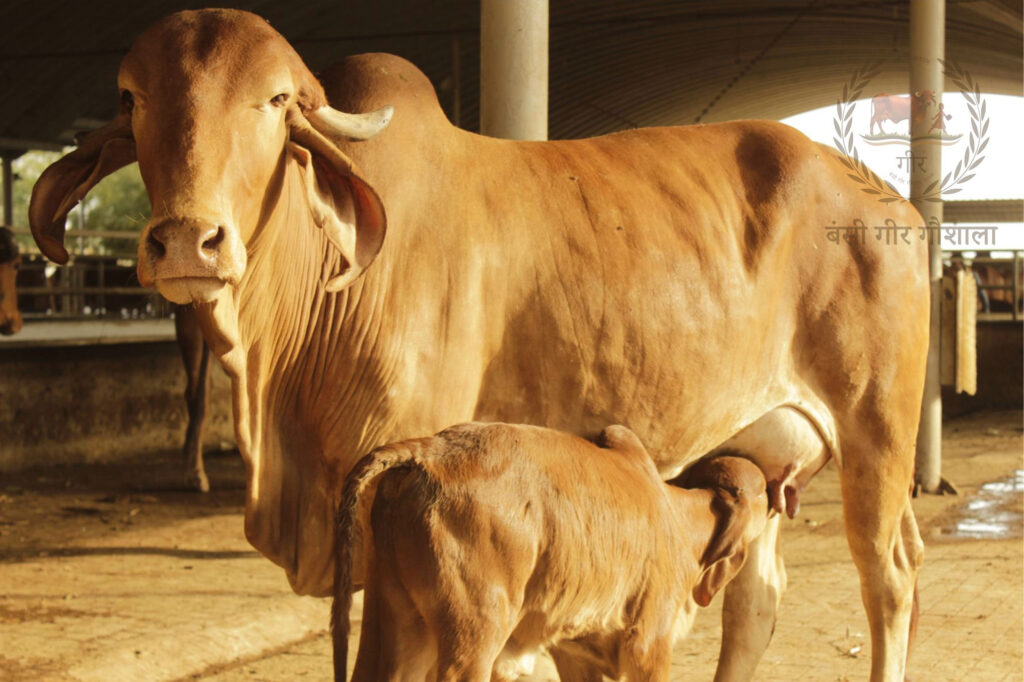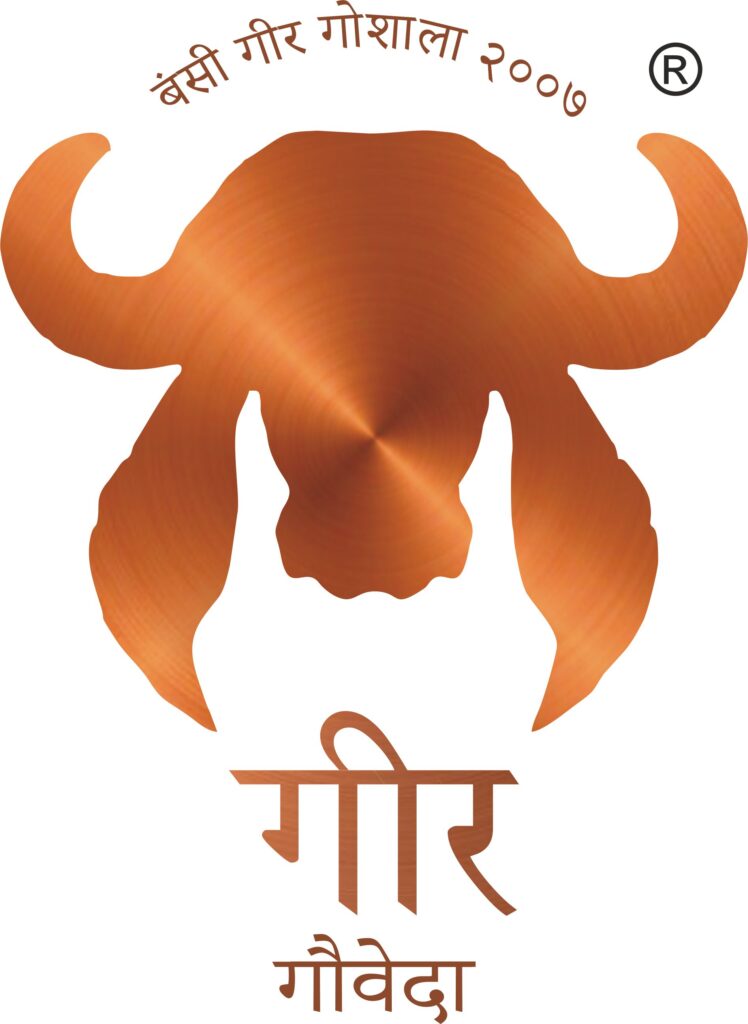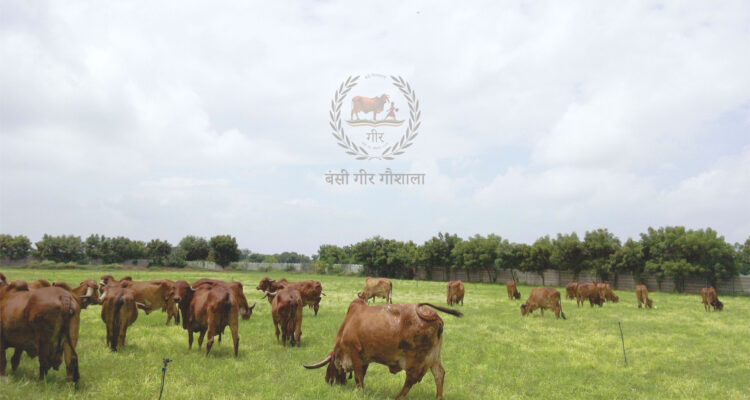The award-winning cow habitat, Bansi Gir Gaushala in Gujarat, is focused on reviving the native Gir cow breed of India.
Home to 600 Gir cows, the habitat practices the beautiful Vedic practice of ‘Dohan’, which dictates that the calf must feed first to its heart’s content — only the surplus milk is utilised for ghee, rendering it non-violent.
◊ By Rutaksha Rawat
Visit ORGANIC SHOP by Pure & Eco India
Bansi Gir Gaushala in Gujarat, is successfully reviving lost Vedic paradigms in nutrition, healthcare and culture, with notable results.
The Vedas did not view the Cow as an animal, but as the universal divine mother, the ‘Gaumata’. The Vedic approach towards rearing cows and farming is not driven by the physical need for food or economic gain, but rather it is viewed as an act of Sadhana (meditation).
With a mission to infuse this Vedic philosophy into modern life, Bansi Gir Gaushala has devoted itself to the ancient Vedic system of Gopalan (ethical cow rearing), as well as, Gau-Krishi (cow-based agriculture). In recognition of its endeavours, in 2017, the Gaushala was awarded the prestigious national ‘Kamdhenu Award’, conferred on the country’s best managed indigenous cow habitats.
Over 2006 and 2007, the founders of the Gaushala — brothers, Gopal and Gopesh Sutariya — travelled extensively across Gujarat to find purebred indigenous Gir cows and learn personally from the experience of Gopalaks (cowherds) on how best to care for them.
They experimented with practical aspects of Vedic cow rearing and cow-based farming, as well as, Gau Adharit Ayurveda (cow-based healthcare). Over time, the Sutariyas gathered Gir cows from 18 different Gotras or lineages, including those emerging from the Gir cows belonging to the Maharaja of Bhavnagar, the Maharaja of Jamnagar, etc. The number of cows and nandis (bulls) at the Gaushala has now grown to over 600.
INITIATIVES UNDERTAKEN BY BANSI GIR GAUSHALA
Development of the Native Gir Cow Breed – Today, the Gaushala houses almost every type and variety of Gir cow. Breeding within the same bloodline was forbidden in the Vedas, which from a scientific perspective also, is important for preservation of the genetic integrity. Therefore, the Gaushala meticulously maintains records of each and every cow to avoid inbreeding within the same Gotra. As a result, the Gaushala has seen remarkable progress with milk output, fertility and life expectancy of the cows.
The rearing of bulls has been losing relevance in villages and modern dairies with the advent of tractors, chemical-based farming, as well as, artificial breeding methods. In view of the declining population of high-quality Girs, the Gaushala decided to implement the scheme, ‘Nandi Gir Yojana’ under which, trusted villages and Gaushalas are offered bulls at no cost for a period of 2-3 years for purposes of breeding. Till date, over 250 bulls have been offered under this scheme. The Gaushala believes that Nandis or bulls are part of their family, and is opposed to the sale of semen.

The Vedic practice of ‘Dohan’ mandates that the calf must feed first to its fill — only the surplus milk is utilised for ghee, rendering it non-violent.
Revival of the Ethical Vedic Practice of ‘Dohan’ – The Gaushala has inspired thousands of farmers across India to revive the beautiful and humane Vedic practice of ‘Dohan’, wherein the calf feeds to her satisfaction from two anchals (teats), while the remaining two anchals are used to obtain milk for other living beings, including humans. With reducing quality and land area for grazing fields and the separation of farming from dairy, it has become unviable or extremely challenging economically for farmers and dairies to maintain cows at their farms. This has led to a decline in the practice of Dohan, and calves are speedily weaned away from their mother’s milk to maximise output.
The Gaushala believes by practising Dohan across generations, the breed gets strengthened. Both from Vedic and ethical perspectives, a firm adherence to dohan is critical.
Revival of ‘Gauchars’ or Grazing Fields – The Gaushala realised that one of the key challenges that every farmer and cowherd faces in the country is the rapid degradation of Gauchars or grazing fields. The research team at Bansi Gir studied over 100 varieties of grass for their nutritional profiles, as well as, their taste (as per the recipients’).
Some of the most nutritious varieties of grass, which are also appreciated by cows, were used to develop pastures at Bansi Gir Gaushala, and free saplings of such grass varieties (such as Jinjwa) were given out to local farmers to develop similar grazing fields in their respective villages.
Over 5,000 farmers have benefited from the free grass saplings scheme that Bansi Gir initiated. Methods of cow-based agriculture were employed to further enrich the growth and nutritional profile of such grass. Ayurvedic herbs that could be given to cows at various stages of their lifecycle were also studies, and currently, over 30 herbs are included in the Gaushala’s concentrate feed. Significant improvements in the cows’ health and longevity have been observed as a result of these endeavours.
Creating Awareness about Significance of Native Cow Breeds – The Gaushala has inspired hundreds of farmers across India to focus on the native cow breeds of their respective regions, with extremely encouraging results. Hundreds of farmers flock to Bansi Gir Gaushala every year with a desire to revive indigenous cow breeds in the country, with the focus generally being on the Gir breed.
India has over 36 local breeds of cattle besides the Gir, including Sahiwal, Kankrej, etc, but their population is in decline due to the influx of foreign breeds such as the Holstein Friesian. The Gaushala, through its many educational campaigns and initiatives, aspires to bring about greater awareness, and consequent conservation of the native cow breeds in the country.
Revival of ‘Gau Adharit Ayurveda’ or Cow-Based Healthcare – The Gaushala bears testimony to the effective synergies between Vedic cow rearing and Ayurveda. Collectively, they have the potential to ease physical suffering and save billions of dollars that are spent on chemical-based medicines. Bansi Gir Gaushala is associated with leading Ayurvedic practitioners from across India, and has developed several path-breaking cow-based medicines and supplements under their guidance and supervision. Every day, patients of the Gaushala’s clinic report encouraging results across a variety of health conditions such as insomnia, hair fall, joint pains, infertility, menstrual irregularities, asthma, digestive disorders, skin allergies, etc.
Revival of ‘Gau Adharit Krishi’ or Cow-Based Agriculture – The Gaushala has been active in promoting natural Gau Adharit Krishi or cow-based agriculture among farmers through free distribution of a revolutionary agricultural probiotic bacterial culture developed with the help of dedicated agricultural scientists and Ayurvedic experts. This culture helps to replenish soil microflora that is heavily depleted due to years of chemical-based farming, and helps establish a conducive ecosystem for plants to absorb micronutrients available in the soil. Thousands of farmers across India have reported positive results with the use of this probiotic culture called Go-Krupa Amrutam. This culture is helping farmers go natural and adopt native cows in a successful combination of ethical cow rearing and agriculture to improve crop quality, as well as, profitability.
Revival of Vedic Education – The Gotirth Vidyapeeth was established in 2016 as a traditional school (Gurukul) on Bansi Gir Gaushala’s premises. At the Gurukul, students learn Vedic mathematics, Sanskrit, Gopalan (ethical cow-rearing), agriculture, yoga, Ayurveda, classical arts and Kalaripayattu (an Indian martial art form), etc. The Gurukul is supported by renowned Vedic scholars, saints and teachers.

GIR AHINSAK GAU GHEE (GIR NON-VIOLENT COW CLARIFIED BUTTER)
Bansi Gir’s ghee (clarified butter) is called Gir Ahinsak Gau Ghee, which literally translates to ‘non-violent ghee or clarified butter of Gir cow’.
“‘Non-violent’ because, as mentioned, we do not deprive the calf of its mother’s milk, and practise the ethical dohan method, which dictates that the calf must feed first to its heart’s content — only the surplus milk is utilised to prepare ghee, rendering it non-violent,” says Gopesh Sutariya.
Also non-violent is the Gaushala’s practice of retaining older, non-lactating cows for their complete life term. “We are also strictly against employing artificial interventions to induce breeding or increase milk production. As a result, the percentage of milk yield at our Gaushala is mostly around 20% compared with the 30-65% yield received in conventional dairies,” shares Gopesh.
Benefits of Gir Ahinsak Gau Ghee
Many studies have pointed out the positive effects of milk and ghee on brain function owing to its rich nutritional content, which includes vitamins, minerals and beneficial fatty acids such as CLA (Conjugated Linoleic Acid), Omega 3 & 6 fatty acids, etc.
Gir Ahinsak Gau Ghee balances out the Vata and Pitta doshas in Ayurveda, strengthens the immune system, heightens vitality, is good for voice and vision, builds stamina, makes the skin glow, and whets the appetite.
The Vedic Bilona Process of Ghee-Making
The Vedic bilona process of ghee-making uses whole milk and not just cream. As a result, each litre of ghee requires 25-30 litres of milk, in contrast to conventional dairy ghee, which is made from residual cream. In the bilona method of ghee-making, the cooking is done in a brass vessel on wood-fire. This kind of ghee is greatly emphasised in Ayurveda as a potent tonic with medicinal properties. The slow-burning flame of the wood fire helps retain most of the nutrients in the ghee as opposed to ghee made in higher temperatures.
Gir Ahinsak Gau Ghee is a natural handmade product. Its smell, taste, colour and consistency may vary depending upon the weather and other conditions, but the ghee’s purity remains unchanged in all circumstances.
The colour of the ghee may get whiter as it ages, a highly desirable quality in Ayurveda, which considers aged ghee to be more potent in terms of its medicinal qualities. In fact, it is this aged white ghee that the Gaushala uses to formulate its cow-based medicines and supplements.
CONTACT DETAILS
Address: Shantipura Circle, Near Sarkhej-Gandhinagar Highway, Ahmedabad, Gujarat 380058, India
Ph: +91 63548 00089
Email: [email protected]
Websites: www.bansigir.in, www.girgauveda.com, www.sose.in



can we start the same exercise in Gwalior under your guidance.
We only have currently 10 cattle.
Kindly write to Mr Sutariya at [email protected]
Please help on gir goshala at Ujjain
CONTACT DETAILS
Address: Shantipura Circle, Near Sarkhej-Gandhinagar Highway, Ahmedabad, Gujarat 380058, India
Ph: +91 63548 00089
Email: [email protected]
Website: http://www.bansigir.in
Please need 10 cows
we want 10 gir hefier
Kindly contact the company directly through their website.
Interested in gir cow